2014 Fifa World Cup: Where are the 12 host stadiums in Brazil?
- Published

From the Amazon basin in the north to the banks of the River Guaiba in the south, 12 stadiums across Brazil will play host to matches at next summer's World Cup.
Three of the arenas will miss Fifa's end-of-year deadline for completion, while a further three remain a long way from being finished.
But which grounds are finished? Where are they? And what can fans expect?
(All times are British Summer Time)
Arena De Sao Paulo, Sao Paulo
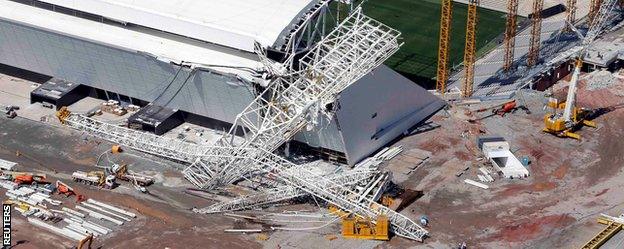
Capacity: 65,807 (20,000 of which are temporary seats).
Opening: A new build for the tournament, the new home of Corinthians is due to be completed in time for the opening game which it will host. It has staged two test matches, but was not at full capacity for either.
Altitude: 792m (2,598ft).
Climate: Highs of around 20C and lows of 13C with a 30% chance of rain.
Time Zone: GMT -3 hours.
Approximate distance from Rio: 269 miles.
Where is it?: On a plateau in the south-east, on the Atlantic coast.
Fixtures: 12 June, Brazil v Croatia, 21:00; 19 June, Uruguay v England, 20:00; 23 June, Netherlands v Chile, 17:00; 26 June, South Korea v Belgium, 21:00; 1 July, Second-round, Winner Group F v Runner-up Group E, 17:00; 9 July, Semi-final, Winner Quarter-final 3 v Winner Quarter-final 4, 21:00.
Background: Corinthians, who currently play at the Estadio do Pacaembu, were granted permission to build a new stadium as long ago as 1978 but only announced construction of their new home in 2010. The Estadio do Morumbi, home of Sao Paulo FC, was originally chosen to represent the city of Sao Paulo in the World Cup but when funding fell through to renovate it, the opening game was moved to the new Arena in 2011. After the tournament 20,000 temporary seats will be removed.
Construction has been blighted by the deaths of three workers. Two were killed when a crane collapsed in November 2013, and another died in March 2014 after falling from a stand.
Estadio Mineirao, Belo Horizonte

Capacity: 57,400.
Opened: 1965 (reopened after renovation in February 2013).
Altitude: 800m (2,624ft).
Climate: Dry and warm. June and July tend to be the coolest months of the year, but temperatures still peak at 25C most days.
Time Zone: GMT -3 hours.
Approximate distance from Rio: 278 miles.
Where is it?: Surrounded by mountains inland from Rio and Sao Paulo.
Fixtures: 14 June, Colombia v Greece, 17:00; 21 June, Argentina v Iran, 17:00; 24 June, Costa Rica v England, 17:00; 17 June, Belgium v Algeria, 17:00; 28 June, Second-round, Winner Group A v Runner-up Group B, 17:00; 8 July, Semi-final, Winner Quarter-final 1 v Winner Quarter-final 2, 21:00.
Background: It took three years and 695 million Brazilian reais (£185m) to give the historic Estadio Mineirao a comprehensive facelift. The stadium is a listed national monument, so the facade and roof had to be preserved, but the pitch was lowered by 3.4m to allow the removal of a running track and construction of new seating nearer to the pitch.
Although it was the second World Cup venue to be completed, in February 2013, teething problems resulted in the stadium's operators being fined. However, Fifa general secretary Jerome Valcke described the stadium as "beautiful" prior to the Confederations Cup, when it hosted three games . It will also host football at the 2016 Olympics.
Estadio Castelao, Fortaleza
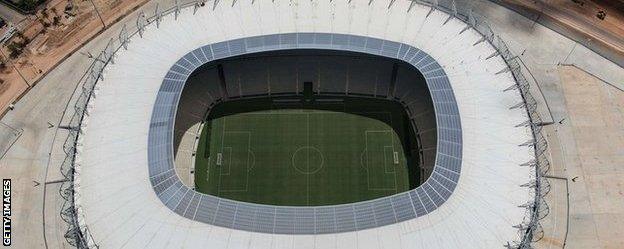
Capacity: 58,000
Opened: 1973 (reopened in January 2013).
Altitude: Sea level.
Climate: Daily temperatures peak at around 30C throughout the year, although the city sometimes benefits from a sea breeze. Occasional rain showers are not uncommon in June.
Time Zone: GMT -3 hours.
Approximate distance from Rio: 1,617 miles.
Where is it?: A 'fortress' port on the north-east coast of Brazil, it has 16 miles of beaches.
Fixtures: 14 June, Uruguay v Costa Rica, 20:00; 17 June, Brazil v Mexico, 20:00; 21 June, Germany v Ghana, 20:00 24 June, Greece v Ivory Coast, 21:00; 29 June, Second-round, Winner Group B v Runner-up Group A, 17:00; 4 July, Quarter-final, Winner Second-round 1 v Winner Second-round 2, 21:00.
Background: The renovation of the Estadio Castelao was completed on time and within budget, making the stadium the first World Cup venue to be declared ready. Work began in March 2011, and cost 518m reais (approximately £167m).
The city of Fortaleza sits on Brazil's north-east coast, and is a popular tourist destination because of its beaches. The new Castelao aims to minimise the impact of the heat on players and spectators.
Estadio Do Maracana, Rio de Janeiro
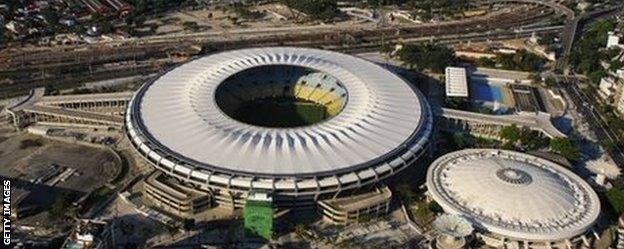
Capacity: 76,804.
Opened: 1950 (reopened after renovation in June 2013).
Fixtures: 15 June, Argentina v Bosnia-Hercegovina, 23:00; 18 June, Spain v Chile, 20:00; 22 June, Belgium v Russia, 17:00; 25 June, Equador v France, 21:00; 28 June, Second-round, Winner Group C v Runner-up Group D, 21:00; 4 July, Quarter-final, Winner Second-round 5 v Winner Second-round 6, 17:00; 13 July, World Cup final, 20:00.
Altitude: Sea level.
Climate: June and July are Rio's coolest months, but the daily temperature peak is typically 25C. Those months tend to be dry, but humidity remains fairly high all year.
Time Zone: GMT -3 hours.
Where is it?: On the Atlantic coast, close to the Tropic of Capricorn.
Background: Renovation of this iconic venue was completed just in time for the Confederations Cup last summer. Work only began in earnest in September 2010 - three years after Brazil was officially handed the World Cup. The stadium formally reopened on 2 June when Brazil drew 2-2 in a friendly with England, and hosted three Confederations Cup matches.
Since then venue has resumed its role as the venue for derby matches between Rio's biggest teams - Flamengo, Fluminense, Botafago and Vasco da Gama.
The pitch was re-laid in October 2013. It is one of four football venues for the 2016 Olympics and will also host the opening and closing ceremonies.
Estadio Nacional, Brasilia
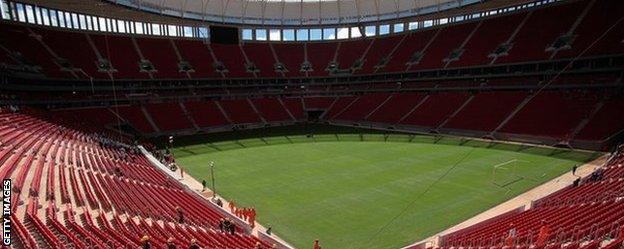
Capacity: 68,009.
Opened: 1974 (reopened after renovation in May 2013).
Fixtures: 15 June, Switzerland v Ecuador, 17:00; 19 June, Colombia v Ivory Coast, 17:00; 23 June, Cameroon v Brazil, 21:00; 26 June, Portugal v Ghana, 17:00; 30 June, Second-round, Winner Group E v Runner-up Group F, 17:00; 5 July, Quarter-final, Winner Second-round 7 v Winner Second-round 8, 17:00; 12 July, Third-place match, 21:00.
Altitude: 1,172m (3,845ft).
Climate: Dry and fairly warm. June and July are the two driest months of the year in Brasilia. Temperatures tend to peak at 25C most days, while humidity drops.
Time Zone: GMT -3 hours.
Approximate distance from Rio: 724 miles.
Where is it?: The capital of Brazil sits in the central highlands.
Background: Construction was problematic and the original budget almost tripled - government auditors said in May the cost will be over two billion reais (£535m). That makes it the most expensive of Brazil's World Cup venues, and reportedly the second costliest football venue ever built.
It will host seven games - the joint most along with the Maracana - but there are fears that afterwards it could become a "white elephant as the city's clubs all play in the lower leagues and attract very small crowds.
Work began in August 2010 but was interrupted in June 2012 when a worker fell to his death on site
Arena Pernambuco, Recife
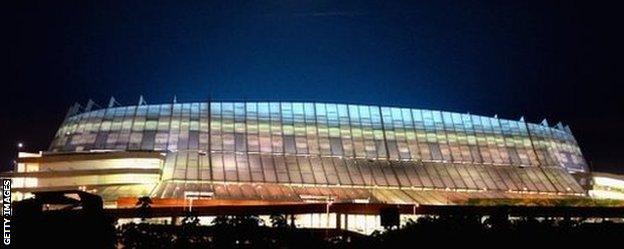
Capacity: 42,800
Opened: May 2013.
Fixtures: 15 June, Ivory Coast v Japan, 02:00; 20 June, Italy v Costa Rica, 17:00; 23 June; Croatia v Mexico, 21:00; 26 June, United States v Germany, 17:00; 29 June, Second-round, Winner Group D v Runner-up Group C, 21:00.
Altitude: Sea level.
Climate: Wet. It rains in Recife on average 224 days a year - which is nearly double Manchester's average. Temperatures tend to peak at 28C in June and July, which are Recife's two wettest months. Humidity is also usually high during these months.
Time Zone: GMT -3 hours.
Approximate distance from Rio: 1,426 miles.
Where is it?: On the Atlantic coast on the east of Brazil, close to the equator and among tropical forests.
Background: This brand new stadium was built in an economically deprived area on the outskirts of Recife, and will eventually form part of a leisure complex and residential development which it is hoped will act as a catalyst for local regeneration.
Construction progress was slower than Fifa would have liked, but the stadium was eventually declared operationally ready on 20 May 2013, with a friendly between Nautico and Sporting Lisbon serving as a test event two days later.
Arena Fonte Nova, Salvador
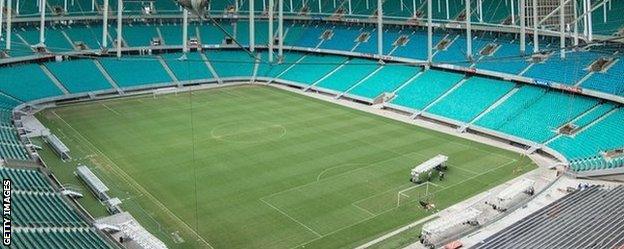
Capacity: 48,747.
Opened: 1951 (renovation completed April 2013).
Fixtures: 13 June, Spain v Netherlands, 20:00; 16 June, Germany v Portugal, 17:00 20 June, Switzerland v France, 20:00; 25 June, Bosnia-Hercegovina v Iran, 17:00; 1 July, Second-round, Winner Group H v Runner-up Group G, 21:00; 5 July, Quarter-final, Winner Second-round 3 v Winner Second-round 4, 21:00.
Altitude: Sea level.
Climate: June and July are Salvador's coolest months, but temperatures still typically peak at 26C.
Time Zone: GMT -3 hours.
Approximate distance from Rio: 1,008 miles.
Where is it?: The largest city on the north-east coast.
Background: The Arena Fonte Nova rose from the rubble of its predecessor, with 92% of the debris from demolition used to construct the brand new venue. The stadium, which took 32 months to construct, was the third World Cup venue to be completed and cost 592m reais (£160m).
Its most distinctive element is its unusual horse-shoe design. There is a large opening in the stands behind the southern goal, behind which lies an open paved area.
This space is called the Praca Sul (Southern Square) and can easily be converted into an amphitheatre to host concerts and shows. The design also boosts air circulation within the stadium.
Estadio Pantanal, Cuiaba
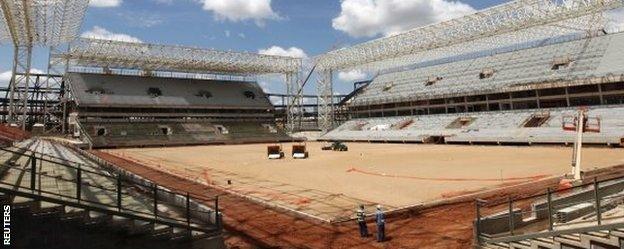
Capacity: 42,968.
Opened: April 2014.
Altitude: 165m (541ft).
Climate: Hot. The temperatures in Cuiaba are consistently high in June and July, rising to daily highs of just over 30C, while it can reach a sweltering 37C. Thunderstorms are a possibility, with humidity expected to be in the 60-70% range.
Time Zone: GMT -4 hours.
Approximate distance from Rio: 1,201 miles.
Where is it?: Right in the centre of South America, close to the Bolivian border.
Fixtures: 13 June, Chile v Australia, 23:00; 17 June, Russia v South Korea, 23:00; 21 June, Nigeria v Bosnia-Hercegovina, 23:00; 24 June, Japan v Colombia, 21:00.
Background: The stadium was purpose built for the World Cup, and is likely to have its capacity reduced by 10,000 after the tournament. It is one of the smallest World Cup venues, and there are question marks over its long-term value after the tournament. The city's two teams, Cuiaba and Mixto, play in the third and fourth tiers of Brazilian football respectively, usually in front of sparse crowds
Construction hit a number of snags, including a fire in October 2013, meaning the stadium did not host its first test event until April. In May a worker died after being electrocuted during the installation of a communications network.
Estadio Da Baixada, Curitiba
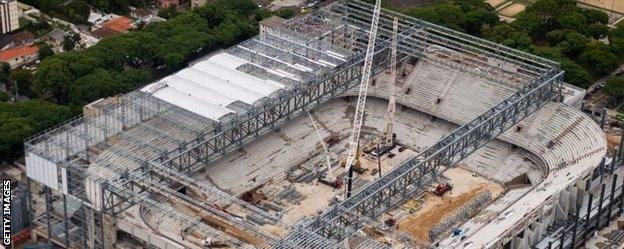
Capacity: 41,456.
Opened: April 2014.
Altitude: 920m (3,018 ft).
Climate: The playing conditions in Curitiba are relatively cool and comfortable with the temperature usually peaking around 20C and a good chance of some rain.
Time Zone: GMT -3 hours.
Approximate distance from Rio: 523 miles.
Where is it?: South of Sao Paulo, one of the cooler cities in Brazil which saw snow fall this year.
Fixtures: 16 June, Iran v Nigeria, 20:00; 20 June, Honduras v Ecuador, 23:00; 23 June, Australia v Spain, 17:00; 26 June, Algeria v Russia, 21:00.
Background: The stadium was the penultimate to be opened, and construction delays proved a major headache for Fifa. Frustrated by the lack of progress, football's governing body threatened to move Curitiba's games elsewhere, only confirming its inclusion in February this year.
The stadium was originally built in 1914 so could be said to be the "oldest" venue at the World Cup. Yet it in 1999 it was rebuilt from scratch, meaning that before World Cup renovations began it was already regarded as one of the most modern stadiums in Brazil.
Estadio Amazonia, Manaus
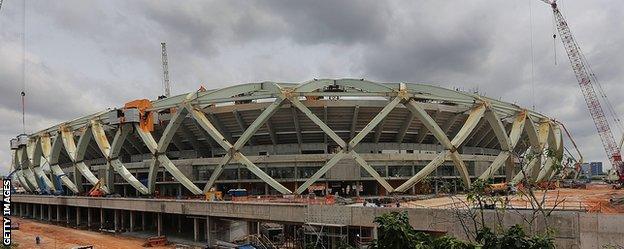
Capacity: 42,374
Opened: March 2014.
See how much remains to be done at Arena Amazonia
Altitude: 72m (236ft)
Climate: Difficult. Tropical heat with tropical storms. Highs are a toasty 30C with a 40% chance of thunderstorms in June, with humidity up to 80%. Expect to see plenty of drinks breaks.
Time Zone: GMT -4 hours.
Approximate distance from Rio: 2,659 miles.
Where is it?: The capital of the state of Amazonas, Manaus is the furthest north of the host cities.
Fixtures: 14 June, England v Italy, 23:00; 18 June, Cameroon v Croatia, 23:00; 22 June, United States v Portugal, 23:00; 25 June, Honduras v Switzerland, 21:00.
Background: The arena has an elaborate steel structure, imported from Portugal, which envelops the playing area like an indigenous woven basket. Over 95% of the material from the old, demolished, stadium will be reused.
This was arguably the most complicated construction project undertaken for the World Cup, in part due to the climate but also because of the location. An urban island in the heart of the rainforest, Manaus is very hard to reach by vehicle, so most materials arrived by plane or ship.
Construction was overshadowed by the deaths of three workers in accidents. Two were killed in separate falls in March and November 2013, while another died in February 2014 following an accident involving the dismantling of a crane. A fourth worker died of a heart attack on site last year.
Estadio Das Dunas, Natal
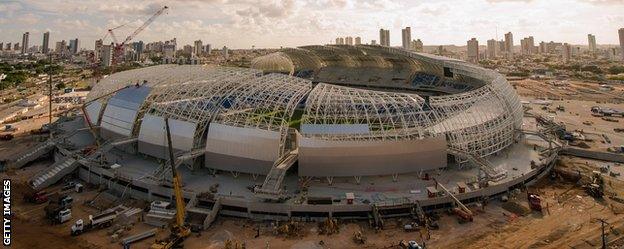
Capacity: 42,086.
Opening: January 2014.
Altitude: 45m (148ft).
Climate: Humidity could be a problem for players in Natal, with an average of 97% humidity in the middle of June. That drops down as the tournament progresses however.
Time Zone: GMT -3 hours.
Approximate distance from Rio: 1,612 miles.
Where is it?: Between Fortaleza and Recife on the north-east coastline, Natal is the state capital nearest to both Africa and Europe.
Fixtures: 13 June, Mexico v Cameroon, 17:00; 16 June, Ghana v United States, 23:00; 19 June, Japan v Greece, 23:00; 24 June, Italy v Uruguay, 17:00;
Background: The original Machadao stadium was demolished in 2011 to make way for the new build, with work beginning on the Estadio Das Dunas a year later. Designed to replicate sand dunes, the stadium's first match was a derby between ABC and America in January 2014.
Estadio Beira-Rio, Porto Alegre

Capacity: 48,849.
Opened: 1969, but reopened in February 2014.
Altitude: 47m (154ft).
Climate: It can get down to a chilly 10C at Porte Alegre in June and July with highs only around 19C.
Time Zone: GMT -3 hours.
Approximate distance from Rio: 982 miles.
Where is it?: The furthest south of the host cities, Porto Alegre sits on a huge freshwater lagoon called Lagoa dos Patos (Lagoon of the Ducks), which is 174 miles long.
Fixtures: 15 June, France v Honduras, 20:00; 18 June, Australia v Netherlands, 17:00; 22 June, South Korea v Algeria, 20:00; 25 June, Nigeria v Argentina, 17:00; 30 June, Second-round, Winner Group G v Runner-up Group H, 21:00.
Background: Originally built in 1969, and known as the Estadio Jose Pinheiro Borda, the stadium has been extensively revamped for the World Cup, with stands moved closer to the pitch and covered by a roof to shield fans from the elements.
Although the stadium opened in February, temporary facilities - such as media facilities and hospitality areas - had not been finished. They will only be completed at the last minute following wrangling over whether the cost should be covered by the public purse or the stadium's owners, top-flight side Internacional.